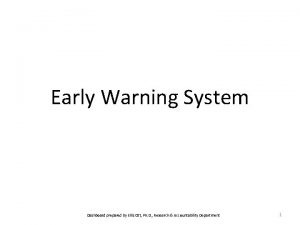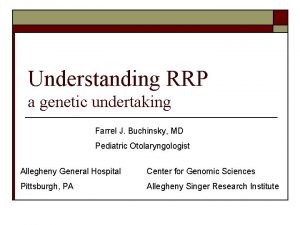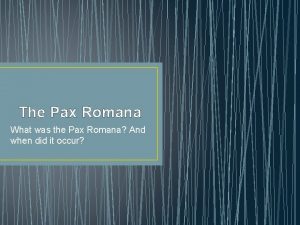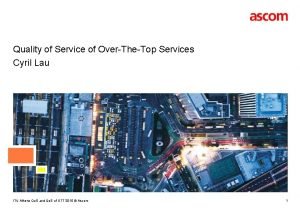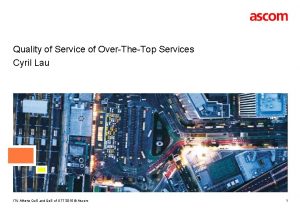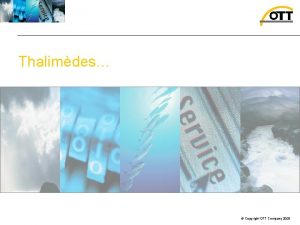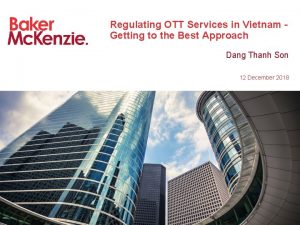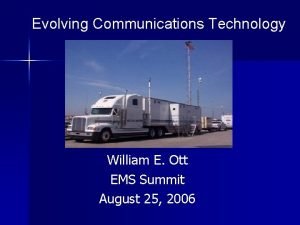Economic impact of OvertheTop OTT services Economic impact





























- Slides: 29

Economic impact of Over-the-Top (OTT) services

Economic impact of Over-the-Top (OTT) services • SG-3 has committed to a work item on the economic impact of over-thetop (OTT) services. • The resultant draft report was posted in advance of this meeting. • A key threshold question has been to establish a working definition of OTT services so as to establish bounds to the scope of the study. • With that established, the draft studies seeks to objectively present: – Opportunities and impacts associated with OTT services – Policy challenges – Policy approaches attempted or taken in various parts of the world

Structure and topics addressed in the draft report 1. 2. Introduction What are OTT services, and how do they differ from other online services? § Working definitions for purposes of this report § Examples of OTT services for purposes of this report § Examples of online non-OTT services for purposes of this report 3. 4. 5. Opportunities and impacts associated with OTT services Policy challenges Policy approaches attempted or taken in various parts of the world § Brazil, India, Oman, the UAE, South Korea, the EU, the US 6. Concluding remarks

WHAT ARE OTT SERVICES? 4

What are OTT services, and how do they differ from other online services? • A definition of OTT services might be relevant for two distinct reasons: – If policy or regulatory measures were ever required, it might be necessary to have a definition in order to determine to which services they apply. – For this study itself, a definition is necessary in order to bound the scope. • Since this is a technical study, it is neither necessary nor appropriate to arrive at a single, recommended definition for regulatory or policy purposes; rather, the study seeks to identify any relevant definitions that are in use, and note the strengths and weaknesses of each. • In terms of establishing and bounding the scope of the study itself, however, it is necessary to develop at least a rough working definition. • If a regulatory definition is ever needed, it need not be the same as the definition used to scope this study. 5

What are OTT services, and how do they differ from other online services? • There a great many distinct online services. • In one recent study, only the first two groupings of online services should be viewed as being OTT services. Source: Baldry, Steingröver, and Hessler (2013), “The rise of OTT players – what is the appropriate regulatory response? ” (see also TRAI India)

What are OTT services, and how do they differ from other online services? • “OTT Communication refers to services whose primary applications lie in communications but use the internet as the transport medium. This is especially relevant to telecom operators since these services operate in a similar space as traditional voice and messaging services. ” - Detecon(2013), “The rise of OTT players – what is the appropriate regulatory response? ” • “OTT services [consist]of (a) OTT-0 services, which are OTT services that qualify as [regulated] ECS, (b) OTT-1 services, which are OTT services that do not qualify as ECS but … potentially compete with ECSs and (c) OTT-2 services [the rest. ]” - BEREC (2015), “Report on OTT services” • OTT services are online services that compete to some degree with traditional telecommunications or broadcasting services. - WIK/TNO (2015), “Over-the-Top (OTT) players: Market dynamics …”

What are OTT services, and how do they differ from other online services? • Competition with traditional telecommunications and/or broadcasting services features prominently in most definitions of OTT services. • In principle, the degree to which one service can function as an economic substitute for another (i. e. the degree of competition) could be measured using econometric techniques – a useful property. • In practice, determining whether substitution is taking place can be tricky. • For purposes of the draft report, we have taken competition with traditional telecommunications and/or broadcasting services to be the characteristic that distinguishes OTT services from other online services.

Possible exmaples of OTT services • There are many IP-based services that appear to compete with existing, traditional telecommunications or broadcasting services such as: – – – Voice services SMS services Teleconferencing Broadcast (linear) video Video on demand • “The best known examples of OTT are Skype, Viber, Whats. App, Chat On, Snapchat, Instagram, Kik, Google Talk, Hike, Line, We. Chat, Tango, ecommerce sites (Amazon, Flipkart etc. ), Ola, Facebook messenger, Black Berry Messenger, i. Message, online video games and movies (Netflix, Pandora). ” - India TRAI (2015), Regulatory Framework for Over-the-top (OTT) services

Trends suggest substitution of online messaging for SMS Source: Analysys Mason (2014)

Trends suggest substitution of Vo. IP for international calls 11

OPPORTUNITES AND IMPACTS ASSOCIATED WITH OTT SERVICES 12

Benefits of OTT services • Historically, the benefits of the economic transformation driven by online and OTT services tended to be concentrated in developed countries. • As the process of digitisation accelerates, and as more and more people worldwide are connected to the Internet, these benefits accrue to developed and developing countries alike. • Positive effects flow down to small businesses and to individuals. • At the same time, OTT services disrupt many traditional arrangements. 13

Benefits of OTT services • OTT applications may substitute to some degree for traditional telephony and broadcasting, but they also offer many capabilities that go well beyond traditional services. – A Vo. IP service such as Skype, for instance, is not only a telephony substitute, but also a means of enjoying rich videoconferencing. – Instant messaging services can provide far richer services than the traditional SMS services that they are to some extent supplanting. – OTT video services such as You. Tube provide not only access to professionally produced content, but also to user-generated content, thus simplifying and enriching interactions for end-users. 14

Improved (mobile) broadband, handsets and tablets are major drivers of demand for online and OTT services • In many countries, broadband is affordable and widely available. • Nonetheless, gaps persist between developing and developed countries. Mobile broadband subscriptions (2015) Source: ITU (2015) 15

The impact of OTT services on societal welfare • Concerns are often raised about disruption caused by OTT services. – – lost revenues to service providers due espeically to substitution, increased costs to service providers due especially to increased traffic, lost tax revenues to national governments, and transfers of welfare between different countries. • The very considerable gains to consumer welfare often forgotten. – Online services tend to intensify competition, and thus to reduce the spread between cost and price (i. e. the profit margin). – They reduce market inefficiencies caused by imperfectly informed consumers. • Societal welfare is generally defined as the sum of producer welfare and consumer welfare. 16

Impact on traditional service revenues • There seems to be little doubt that revenue is declining for a number of traditional services, and especially for SMS. • The cause is not proven, but the usage trends already noted are suggestive of substitution that is consistent with these concerns. 17

Impact on traditional service revenues • The policy implications of possible substitution are subject to multiple interpretations. • One can argue that technological progress inevitably implies the existence, not only of winners, but also of losers. – Firms that operated steamship lines did not necessarily benefit from the introduction of steam-based locomotives. – Firms dependent on horse-drawn transportation did not necessarily benefit from the introduction of automobiles powered by internal combustion engines. • One can alternatively argue that OTT services are effectively pumping money out of the network operators at the very moment when substantial investments in fibre-based infrastructure and LTE are required. 18

Impact on network operators • OTT services have complex effects on network operator costs, revenue, traffic, and profits – many different things are happening at once. – Traffic growth is respectable, but the rate of growth is not out of control. – Substitution results in lower effective prices to consumers, which not only transfers gain to consumers, but also motivates them to consume more service – this not only benefits the consumers, but also generates new revenue for network operators. – Globally, the number of network users continues to increase, due in part to improving price/performance, thus also driving new revenues. – At the same time, the steady improvement in the price/performance of network and computing equipment lowers unit costs for network operators. • The relative magnitudes differ from case to case, but the news for network operators is by no means all bad. 19

Network usage Fixed Traffic Mobile. Traffic Source: Cisco VNI (2014) data, WIK / Marcus calculations 20

Network infrastructure cost and investment Source: Dell‘Oro data (2014), WIK / Marcus calculations 21

Opportunities and challenges for national economies Source: Marcus 22

POLICY CHALLENGES 23

Competitive neutrality (the level playing field) • There are few who would disagree with the general proposition that similar services that are similarly situated, and that compete with one another, should be subject to obligations that are similar (to the extent that doing so is practical). • This seemingly straightforward principle is difficult to apply in practice. – Are the new services really effective substitutes, are they imperfect substitutes, are they economic complements, or are they something else? – Is the original rationale for the original regulatory obligation really relevant to the online service that competes with it? – How practical and proportionate is it to impose the traditional obligation on a new service – does it impose unreasonably high costs? 24

A range of challenges • Authorisation and licensing: To which services should these apply? • Country of jurisdiction: Whose rules govern? The country of origin, or the country of consumption? • Competition law and economics: Are current rules appropriate for OTTs? • Quality of Service (Qo. S) : Providers of OTT services are rarely subject to equivalent obligations, and may not be able to assure Qo. S anyway. • Promoting the creation, operation and use of OTT and related online services: Ubiquitous access is clearly important. • Security and privacy: OTT services raise issues in these complicated areas, but not necessarily the same issues as traditional services. • Vo. IP caller ID “spoofing”, OTT bypass, and other forms of Vo. IP abuse. 25

POLICY APPROACHES TAKEN; CONCLUDING REMARKS 26

Policy approaches attempted or taken in various parts of the world • Policy approaches taken or proposed vary widely, and among multiple dimensions, from one country to the next, even among countries in the same region. • The report discusses noteworthy approaches taken on multiple continents, representing large countries and small, and including some countries that are developed and others that are arguably still developing. • Countries and regions covered in the draft report today are Brazil, India, Oman, the UAE, South Korea, the European Union, and the United States. • We would welcome suggestions for additional case studies. 27

Concluding remarks • The draft report seeks to explain the opportunities, the threats, and the various regulatory and policy measures that have been taken in order to address these challenges in various regions and countries and around the world that appear to be among the first to confront them. • OTT services are clearly associated with significant opportunities for all; however, they are also associated with a number of new threats. • Existing regulatory provisions that were developed for the switched telephone network tend to be ill-equipped to deal with today’s challenges. • The issues are complex, and may not lend themselves to simple solutions. • In many cases, a global consensus as to what constitutes best practice has not yet emerged. 28

Your views?
 Kristi ott
Kristi ott Ott pressure transducer
Ott pressure transducer Otto motor
Otto motor Ovp ott
Ovp ott Ott se 200
Ott se 200 Vertical angles
Vertical angles Ott business meaning
Ott business meaning Fenn a mennyben az úr minden győztesnek ád akkord
Fenn a mennyben az úr minden győztesnek ád akkord Főember az úton kocsi rázza
Főember az úton kocsi rázza Ken ott ecommerce
Ken ott ecommerce Ott dropout
Ott dropout Ott orpheus mini
Ott orpheus mini Wat zijn modalverben
Wat zijn modalverben Ozolit
Ozolit Ozolit
Ozolit Herwig ott
Herwig ott Ahol nincs te ott nincs én se
Ahol nincs te ott nincs én se Panetha ott
Panetha ott Soara antana
Soara antana Jurg ott
Jurg ott Nadia ott
Nadia ott Ott tenyészik a bús árvalányhaj
Ott tenyészik a bús árvalányhaj Ott tenyészik a bús árvalányhaj
Ott tenyészik a bús árvalányhaj Fred ott's sneeze
Fred ott's sneeze Ha te jézust követed
Ha te jézust követed Elpt ott
Elpt ott Elpt ott
Elpt ott Elpt ott
Elpt ott Positive impact of economic in tourism
Positive impact of economic in tourism Pax ro
Pax ro










